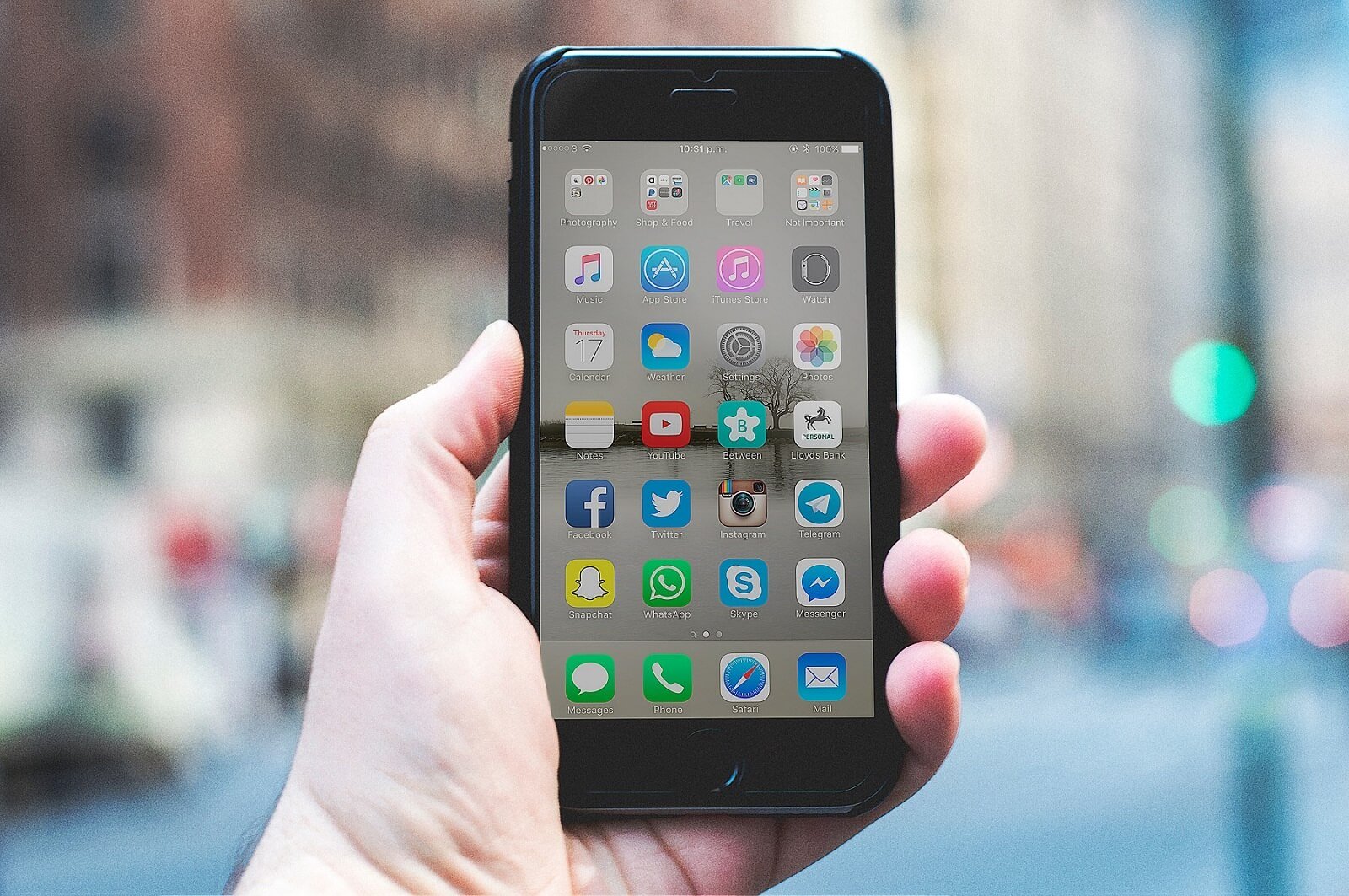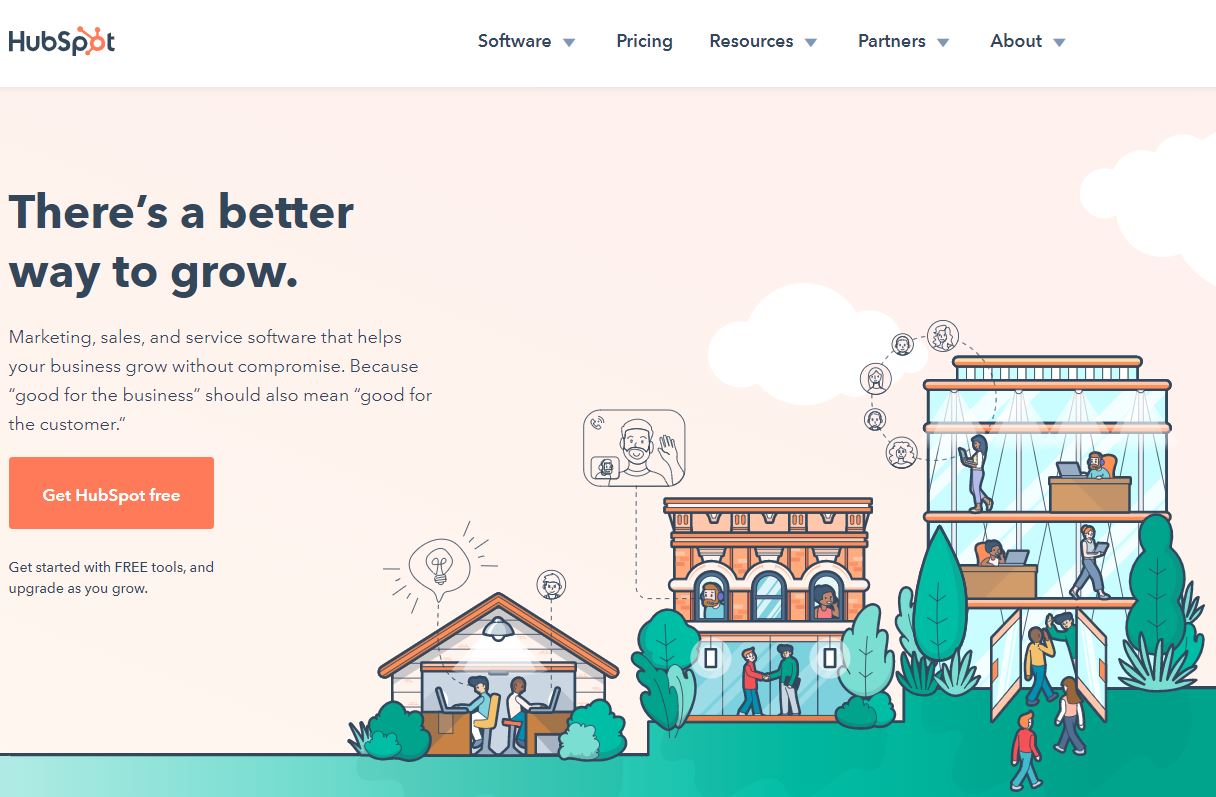Need ideas for what digital marketing channels to focus on?
Reach out to us and we’ll help you find the best ways to spend your marketing budget!
It was in October 1994 when the first web-based banner ad was born courtesy of an advertising campaign for AT&T. The copy read: “Have you ever clicked your mouse right HERE? YOU WILL”. In the four months that followed, 44% of internet users had actually clicked on it, giving the company heaps of advertising mileage.
The publishing of that ad, which is now better known as a display ad, has been referenced as the earliest form of digital marketing. Then again, a display ad is only part and parcel of the entire digital marketing industry. This is just one application of digital marketing using the different available business channels online.
Almost three decades after the launch of the iconic banner or display ad, the industry has evolved beyond ads. It now encompasses a wide range of internet-based strategies using the most effective marketing channels to deliver content and promotional offers.
What is a Digital Marketing Channel?
Digital marketing channels are platforms that you can use to reach your target audience with information about your brand, product, or service such as websites, email, social media, and more. Utilizing these channels allows you to help your customers with any questions or challenges they may have while positioning your business well so that you can be a step closer to your marketing goals.
Not all types of digital marketing channels are cut out for each and every one of your business objectives, though. Some are more suitable for certain types of audiences, while others are set up differently depending on what they’re capable of doing. As such, you must know which digital marketing channel to use and then implement the best practices to achieve a particular goal.
Most of your goals will probably relate to generating leads, raising brand awareness, improving conversions, and ultimately, getting more sales. Together with your digital marketing agency, you can invest in digital marketing strategies to target one or more of those goals.
In the succeeding section, you’ll see a list of digital channels with the greatest potential to address your business’s and audience’s needs.
Effective Digital Marketing Channels
Marketing channels in digital marketing are varied and can be useful for your business goals. Here are the different examples of digital marketing channels and how each can benefit your company.
1. Websites
Your website is a must-have tool for your business as it provides you with a dedicated platform where you can educate audiences about your brand, products, and services. This requires a solid understanding of your target audience and an effective content marketing strategy.
Whatever the size of your company, when you create a website, it can give your business the online presence it needs to communicate and/or sell to prospects. In fact, another study showed that 69% of Americans have purchased an item online. Whether your business is concerned with e-commerce or it’s something that’s more service-oriented, be it B2C or B2B, you should definitely invest in a website. To reduce costs, you can build the website using WordPress, and the good news is there are many free WordPress themes available.
Your website is an ideal channel for your content marketing campaigns. Through blog posts and announcements, you can provide existing and potential customers with valuable and relevant content to help them solve their pain points. Because websites have multimedia capabilities, you can easily distribute different types of content—from articles to infographics and even video. You can even create a digital brochure or two to add a little extra punch to your webpages!
At the rate that people are consuming content, having the right mix of these top-performing content types can exponentially increase your site traffic and engagement. Ultimately, this can result in better brand recognition, authority building, and new sales opportunities for your business.
How Your Website (Content) Can Help You
- Increased organic traffic. People will naturally gravitate to your website for high-quality, relevant, and insightful content that displays your thought leadership.
- Lead generation. When people come to your site, it means they are interested in finding out more about your product or service, making them potential customers for your business.
How to Use Websites: Best Practices and Top Strategies
- Create content assets in various formats. Certain types of content are more effective for a particular stage in the buying cycle. For example, you should reserve product videos for audiences in the consideration funnel and not when they’re barely starting to be aware of your business.
- Promote your content via social media and email marketing. Promoting your content makes it easier for audiences to find it—and possibly share it with others in their network.
Related Content: The Beginner’s Guide to Content Marketing, Content Marketing Resources, Every Blog Content Format You Can Create, and Free Content Marketing Tools [A Complete List]
2. Email
There are several reasons why it’s so hard to dislodge email as a channel that delivers medium to high ROI for your business, but the one thing you can’t take away from email is its versatility. Although email may not be the newest technology available, it allows you to apply the latest trends in content marketing, such as personalization and automation, without hurting your marketing budget.
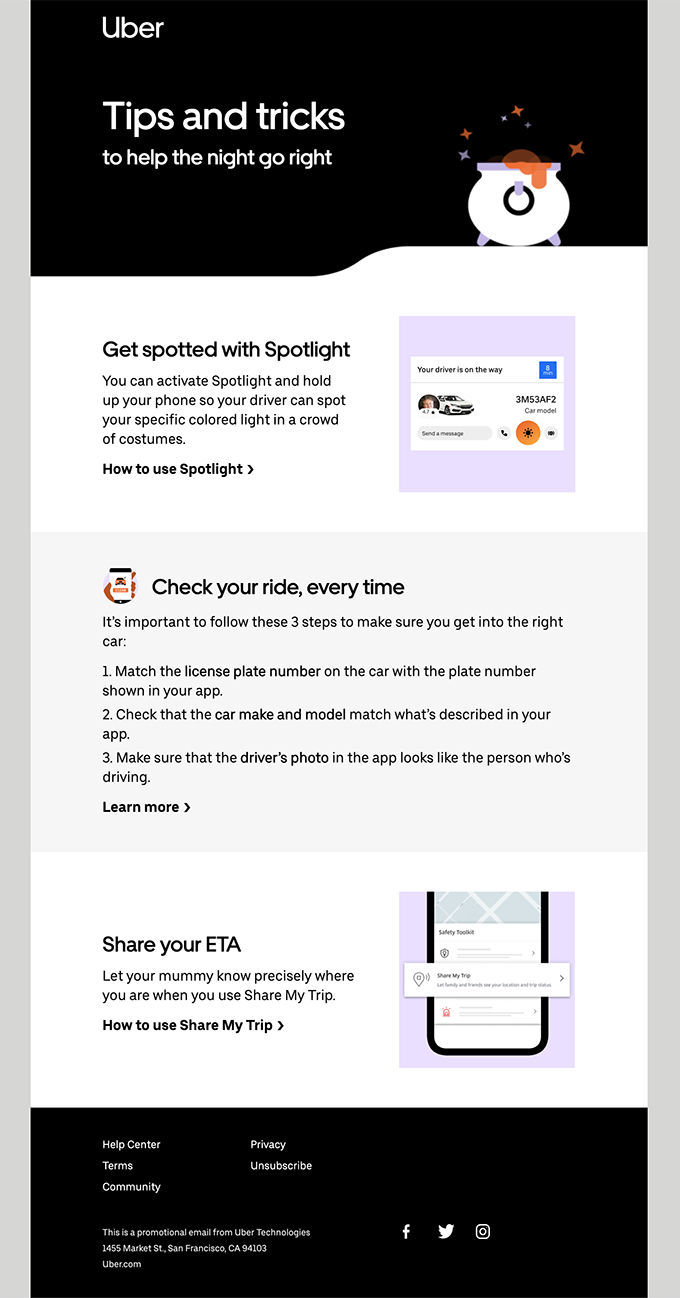 Halloween marketing email from Uber
Halloween marketing email from Uber
Email also has the ability to support other marketing objectives, so it’s no surprise that 73% and 63% of B2B marketers say that email is their top tool for generating leads and driving revenue, respectively.
Beyond lead generation and revenue, email helps you in many more ways, as follows:
- Email has become so widespread that it reached 3.9 billion users in 2020, and the figure is expected to grow to 4.3 billion users in 2023—more than half of the world’s population!
- Email still delivers the best returns, with 73% of respondents of a study ranking the channel as excellent, compared to SEO and paid search at 72% and 67%, respectively.
- Every $1 spent on email marketing, you can expect a $42 average return on investment.
- Up to 62% of opens are done on a mobile device, compared to 10% on desktop.
How Email Can Help You
- Brand awareness and Conversion. Emails are sent straight to users’ inbox, allowing you to deliver branded content as well as those for marketing purposes. This makes email ideal for driving conversions and, ultimately, growth and success for the business.
- Lead nurturing. A series of emails sent to customers is helpful in establishing a relationship and building trust with them, so they’ll eventually make a purchase.
- ROI. Statistical data shows that email remains unbeaten as the channel that generates the highest ROI among any other marketing tactic.
How to Use Email: Best Practices and Top Strategies
- Craft time-sensitive subject headlines. This method encourages those in your contact list to take advantage of your promotional offerings before they end.
- Personalize your email marketing campaigns. Whenever someone takes a specific action, such as visiting your product pages or signing up for a free trial, send them triggered emails containing the right message based on where they are in the buying cycle.
- Reserve email for customer feedback and support. Good customer service is always a good way to increase sales. From surveys to reviews and problem resolution, the uses of email are practically endless!
Related Content: Why Does Email Marketing Work?, Templates for Email Marketing Campaigns, 8 Email Marketing Tools That Will Save You Hours, 10 Insane Statistics Prove Email Marketing is More Powerful than Ever, and Your Guide to Understanding Email Marketing Data
3. Social Media
Social media marketing is on this list for some very worthwhile reasons, but this isn’t just about social media users reaching the 4.48 billion mark. From being a channel that people use to establish personal connections, social media has evolved into something grander, bigger, and better than what it was originally envisioned to be.
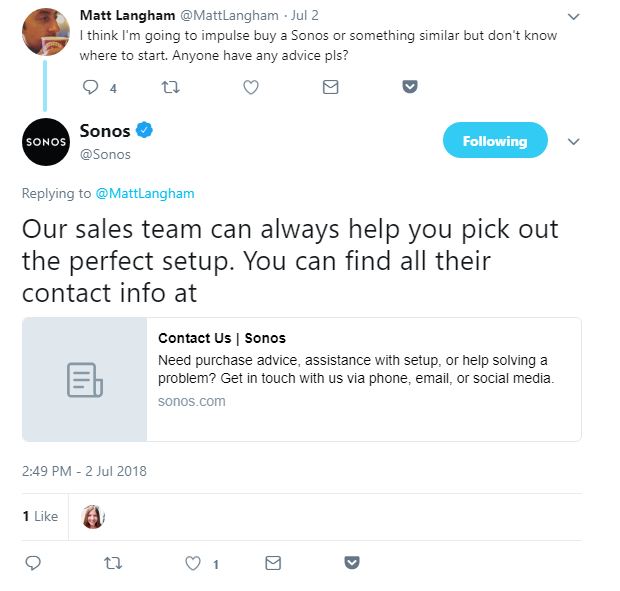 Sonos using the power of social selling on Twitter
Sonos using the power of social selling on Twitter
These days, you can reach out to potential buyers by engaging them in a more personal and authentic fashion. As such, it’s easier to direct your efforts toward organic social media marketing since the platform was initially designed to foster interactions rather than sell to your prospects.
You must invest time in cultivating relationships with your target market as you try to understand the needs and interests of your buyer personas. Ultimately, this can help you generate highly qualified leads on LinkedIn, Twitter, or Facebook—which account for driving 80%, 13%, and 7% of qualified B2B leads, respectively.
Although this can directly drive sales, you should remember that social selling isn’t really about selling at all, so prioritize building a strong, positive relationship.
How Social Media Can Help You
- Customer engagement. Social media allows you to build rapport with your brand followers. With social, you can reinforce your company image by putting names to faces and adding that human touch, which makes your brand more relatable to the public.
- Wider audience range. Social media posts are easy to share, opening up word-of-mouth opportunities that can help you grow your audience or customer base. Even better, it doesn’t cost you a fortune for your content to be shared.
How to Use Social Media: Best Practices and Top Strategies
- Be original. This applies to the topics you tackle and the approach you employ in creating your content. Remember, creativity is a major factor in social engagement.
- Include hashtags in your posts. Word spreads fast when you use the # tag, allowing people to see and jump into the conversation.
Related Content: How to Leverage Social Media to Grow Your Business Exponentially, Build an Effective Social Media Plan in 5 Simple Steps, 6 Social Media Tools Businesses Shouldn’t Go Without, and Social Media Crisis Management Examples (and Lessons)
4. Organic Search (SEO)
Did you know that over 63,000 Google search queries are performed every second? Just imagine how many people are searching on the internet! Given that people use search engines for research, shopping, and entertainment, the opportunities for businesses are huge!
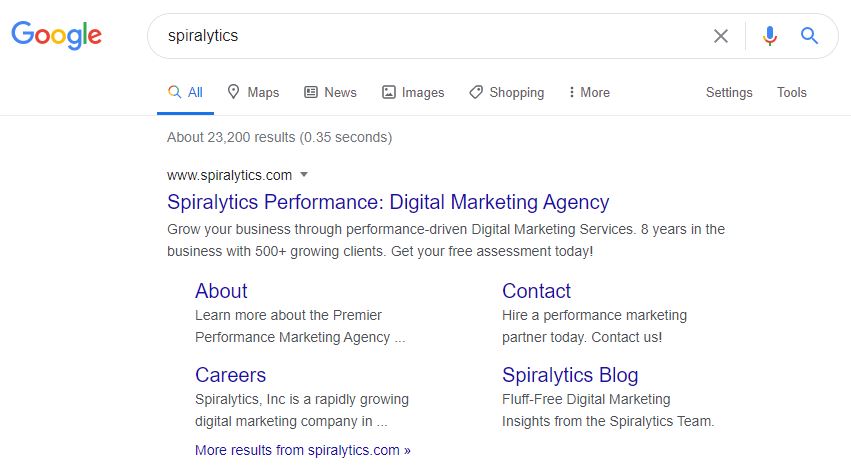
When prospects or customers look for products or services, they’ll tend to go with whoever ranks higher. Standing out from the competition at this stage means that you’ll be capturing new opportunities organically, driving a consistent flow of leads down your sales funnel.
As long as you adopt modern SEO best practices—keyword research, blog post optimization, and linkable content creation—improving rankings on search engines will be a lot easier.
How Organic Search (SEO) Can Help You
- Search rankings. Since people are mainly using search engines to look for information when shopping for products or services, producing quality and optimized content on a regular basis can propel you on top of search results.
- Link building. As you start ranking on search engine results pages (SERPs), you can expect backlinks from high-quality sites to follow.
How to Use Organic Search: Best Practices and Top Strategies
- Optimize your website with on-page and off-page optimization. On-page SEO includes choosing the right keywords and providing meta descriptions for your content, while off-page SEO involves link-building techniques like guest posting. Together, on- and off-page SEO create signals that Google can use to rank your site.
- Implement local SEO to market your business within your community and nearby areas. One of the ways to do local SEO right is to list your business name, address, and phone number (NAP) consistently across your website, business directories, and social media profile as they work like keywords that help Google and users locate your business.
Related Content: A Complete Guide to Search Engine Optimization (SEO), 5 Reasons Why SEO Should Always be a Part of Your Content Strategy, The Most Important Factors That Impact Your Local SEO, and SEO Statistics
5. Paid Search (SEM)
On the surface, it might seem inconceivable that paid search (also called SEM) will have the potential to give you ROI. After all, you’re paying for each click you get, unlike SEO, where people find you organically (and technically for free).
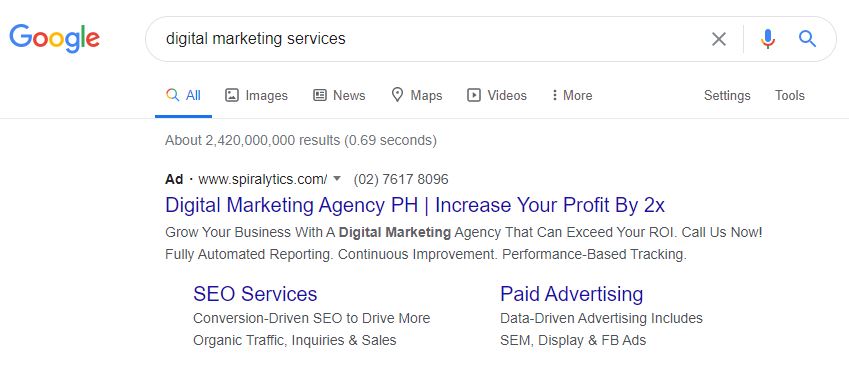
The advantage of using paid search is that your ads are shown above organic search results, making them more visible to users. Even if you have to pay for every time a user clicks on your ad, there’s still a lot of value—monetary and otherwise—that can be had from paid search. Being above organic results means you’re still capturing that engaged searcher before they even have a chance to see their other options (your competitors).
For every $1 you spend on Google Ads, you can earn an average of $2 in return. That’s 100% ROI right in the bag. Conversely, not utilizing the paid ads channel can lead to 50% less revenue.
It’s also been found that PPC results gain 150% more conversions than organic visitors. Clearly, paid search could very well represent a win-win situation for your marketing campaigns.
How Paid Search (SEM) Can Help You
- Brand awareness. Your ads appearing on top of SERPs means instant brand exposure and recall for target users.
- Lead generation and conversions. Just like with SEO, prospective customers are looking for solutions to their problems, but the difference is that SEM involves less work. With SEM, you can target your ads to appear in front of motivated buyers based on their demographic or location without the nitty-gritty of on- or off-page SEO.
How to Use Paid Search: Best Practices and Top Strategies
- Remarket to your audience on Facebook. As the world’s largest social network, you can use Facebook’s remarketing tools to get people who have expressed interest in your ad but weren’t ready to buy yet back to your website.
- Direct users who click on your ads to the right places on your website, such as landing pages that contain a contact form. You can then collect your visitors’ personal information and use it to engage them with your marketing campaigns.
Related Content: A Complete Guide to SEM (Paid Search), SEM Strategies for Businesses, The Pros and Cons of Paid Search Advertising, and Paid Search Optimizations [9 Easy Steps]
6. Mobile
The number of mobile phone users is increasing by the day, and this trend is expected to continue in the years to come. Because of this, it only makes sense to serve promotional content to mobile users. And thanks to geo-targeting strategies where location information is used to recommend products or services more conveniently, customer experience can be consistently improved as well.
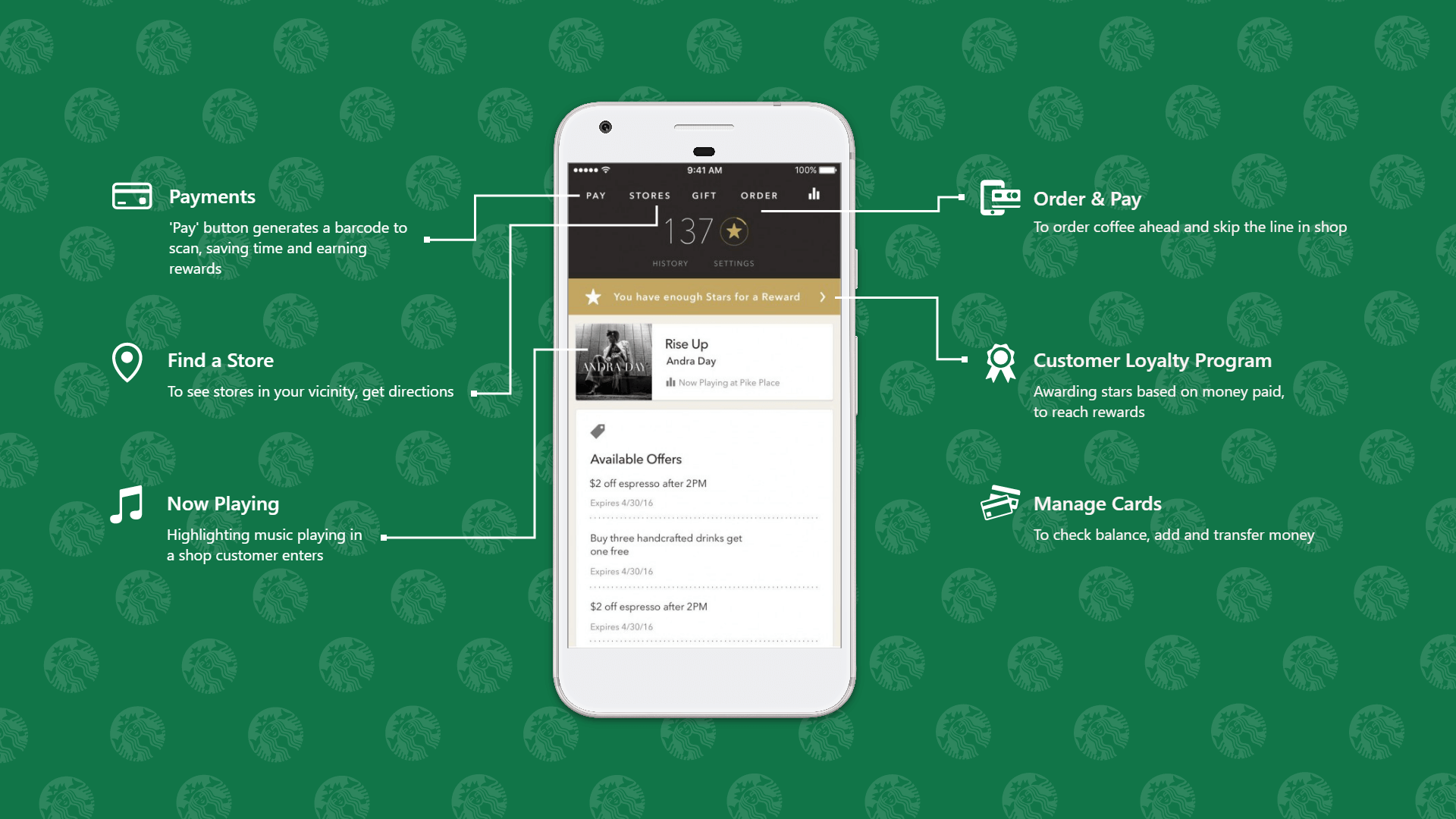 The Starbucks mobile app boasts features that support their sales operations. – Source
The Starbucks mobile app boasts features that support their sales operations. – Source
Smartphone users are also spending 90% of their mobile time using apps and games, which makes mobile apps a profitable marketing channel. Last but not least, mobile can collect customer data, which you can then use to map out a mobile marketing strategy that produces results.
How Mobile Can Help You
- Increase in sales. Mobile shopping is in, making mobile marketing a core strategy especially if you’re in the retail business.
- Creating demand for your product/service while driving brand value. Modern consumers prefer businesses that can deliver the information they want or need in real-time, straight into their mobile devices.
How to Use Mobile: Best Practices and Top Strategies
- Create your mobile website or app. A website or app that’s optimized for mobile viewing is vital for creating a positive and engaging user experience. Must-have features include quick loading pages, compressed images, top-to-bottom scrolling, large buttons, font sizes, and the like.
- Explore mobile technologies like QR (Quick Response) codes that customers can scan to go to your website, access or save your business details, and pay for their purchases—anything to make the interaction between you and your customers more instantaneous. You can check out these best QR code generators for generating QR codes.
Related Content: Reaching Your Audience in the Age of Mobile Marketing, Why You Shouldn’t be Afraid of the Phone When it Comes to Marketing, Push Notifications: An Absolute Necessity for Mobile App Marketing, and How Artificial Intelligence (AI) is Redefining Mobile Marketing
7. Display Ads
Display ads allow you to use images, audio, and video to communicate your advertising message better. These are shown on websites, email platforms, social media, and many other digital channels that offer ad placements, usually in the form of a banner.
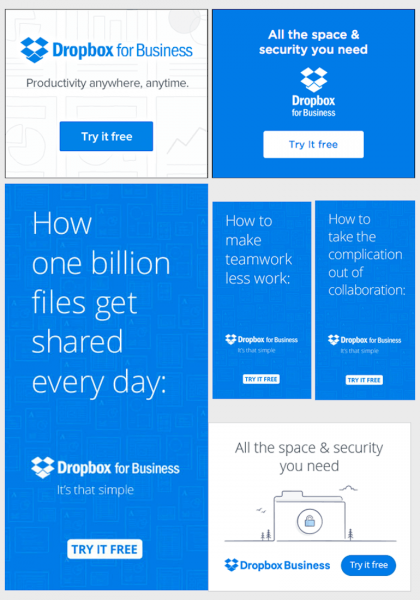
Dropbox banner ads have clean designs that drive brand awareness and draw people in with great USPs. Simple yet effective. – Source
Compared to search ads, display ads generally have lower cost-per-click since there’s more advertising space available across the web than on a search engine. The core difference is that you don’t target keywords. Display advertising success depends on how well you can match your ad to the host website’s audience to drive conversions.
One of the great things about display ads is their ability to track users for retargeting. For example, if a user lands on your website and doesn’t convert, you can track them with a cookie and retarget them with a relevant display ad later on. It should be no surprise to know that with this much contextual relevance, you’ll be generating a lot more conversions at a lower cost-per-click (CPC).
How Display Ads Can Help You
- Brand awareness. Since your ads are distributed via the Google Display Network (GDN), you can gain access to millions of sites across the web, each with their own set of audience.
- Sales and conversion. When done correctly, your ads can compel visitors to pursue an action that you want them to take, whether it’s to buy your product or download your business app.
How to Use Display Ads: Best Practices and Top Strategies
- Highlight your unique selling proposition (USP). Let your customers know how your business can help them—whether it’s quality, value for money, or brand of customer service, which they can’t get anywhere else.
- Avoid hard-sell call to action (CTA) phrases. It’s the first time that visitors are encountering your brand, so choose CTAs that focus more on customers’ needs rather than those of your business.
Related Content: Insightful Display Advertising Statistics, Google Ads Placement Cheat Sheet [Infographic], and Updated Guide to Facebook Advertising Placements [Infographic]
8. Affiliate Marketing
Affiliate marketing describes the partnership between merchants and affiliate marketers to promote a product or service through referrals. The easiest way to identify this type of marketing is when you come across something that contains labels like “sponsored post” or “affiliate link.”
As a marketing or promotional channel, affiliate marketing can be effective in generating leads and driving sales. Regardless of where your target audience is in the customer journey, affiliate marketing serves as a full-funnel strategy that’s worthy of adoption.
How Affiliate Marketing Can Help You
- Broader market reach. Affiliate marketers — also known as publishers — are focused on referring your products or services to a vast network of audiences via websites, social media platforms, blogs, or newsletters.
- Qualified sales leads. To a large extent, affiliate marketers are influencers that audiences trust as they make purchasing decisions. This allows you to connect with customers who are ready to buy following their preferred influencers’ recommendations.
How to Use Affiliate Marketing: Best Practices and Top Strategies
It’s a common misconception that affiliate marketing works better for B2C than B2B primarily because the sales cycle takes longer in the latter. But with the right approach, affiliate programs don’t need to be exclusive to either B2B or B2C. We suggest the following steps:
- Find the right affiliates. Your affiliate partner must be well-known in their niche and have an excellent track record in referring customers with a high lifetime value for your business. Affiliate marketing platforms or networks can be a good place to start your search.
- Build relationships. This holds true for both your affiliates and your target audience. Regular communication with your affiliates keeps them engaged throughout the program, considering that sales cycles in B2B can drag longer. Meanwhile, it’s easier to establish meaningful connections with your target audience when you provide them with valuable, meaningful content.
9. Video Marketing
The value of video in marketing is unquestionable. Many people who are tired of their humdrum routine turn to video not only for entertainment but also for the educational advantages that come with it. There’s no shortage of statistics on video marketing from increased open rates to conversion rates, which should convince you this is a goldmine to explore.
That said, optimizing your video content – which, as a bonus, gets easier by the day thanks to technological innovations – can help you reach the results and metrics you want for your website.
How Video Marketing Can Help You
- Audience engagement. Video appeals to 54% of consumers. Using video, you can be sure more people will be watching, liking, and sharing your content extensively.
- SEO boost. With your video getting a great deal of online exposure, you can expect an increase in your search ranking and website traffic.
How to Use Video Marketing: Best Practices and Top Strategies
- Know the different types of videos for marketing. You can target specific audiences with the right type of video content, such as brand videos for consumers in the awareness stage, case study videos for those in the consideration funnel, or testimonial videos featuring real brands or people that have benefited from your product or service to appeal to customers in the decision funnel.
- Tell a story. Many brands use this approach not only to become more relatable but also to establish continuity as they build campaigns from one stage of the customer journey to another.
Related Content: A Marketer’s Guide on Short-Form Videos and How to Leverage Them, The Ultimate Guide to Video Marketing, How to Incorporate Video into Your Digital Strategy, and 6 Types of Video Content to Supercharge Your Conversions
10. Instant Messaging (IM) Marketing
On top of the various instant messaging applications, many social media platforms also include IM in their services. Instant messaging has become the preferred way of communication over texting and email because of the real-time replies and the feeling of having a real conversation.
Your business can benefit from this as customers prefer a personalized experience, leading to greater conversions and less cart abandonment.
How Instant Messaging Can Help You
- Personalized experience. Using instant messaging, your brand can directly and quickly communicate with customers and potential customers, allowing for a more tailored response to any questions or concerns.
How to Use Instant Messaging Marketing: Best Practices and Top Strategies
- Use Automation. Automating things like answers to frequently asked questions and after-purchase follow-ups can help streamline the process while still imparting a personal touch to make your brand more personable.
- Regulate your “voice.” When messaging a customer or potential customer, ensure your brand voice – your tone, level of formality, and choice of language – is consistent. If you’re all over the place with your style, it might be more challenging for customers to relate to your brand.
11. Online Public Relations
Online PR is an umbrella term for the various strategies and channels businesses use to build awareness and engage with consumers online. Online PR can include identifying and targeting website viewers, studying your industry niche, and searching and communicating with influencers and experts.
Online PR uses our digital connectedness to easily find, communicate with, and ultimately convert your target audience.
How Online Public Relations Can Help You
- Data-driven results. Digital channels can collect data on everything from the number of interactions to time spent on your page. This data can allow your business to adapt to your target market.
- More convenient communication. As opposed to traditional public relations, online PR is a faster and more convenient way to inform and convert people.
How to Use Online Public Relations: Best Practices and Top Strategies
- Hire a specialist. Online PR specialists have their finger on the pulse of your company’s industry and the moods and trends of the digital world. They can quickly identify and take advantage of online trends to keep your business in the spotlight.
- Consider the competition. Your business is likely one of many in your niche. By studying your competition’s actions in the digital space, you can find any gaps your company can fill to drive more traffic to your website or social media page.
12. Influencer Marketing
Influencer marketing is like affiliate marketing; a company collaborates with influencers to gain access to their unique following. Companies do things like send care packages to influencers in relevant spaces. For example, a skincare company gifts products to a beauty blogger for them to review so their followers can find out about the brand.
This marketing channel focuses on building your brand awareness and improving brand trust, though it can also be an excellent channel for conversions.
How Online Public Relations Can Help You
- An established audience relationship. Influencers already have a loyal following who trust the content creator, so your business can advertise to a highly focused and dedicated group of potential buyers.
- Brand loyalty. Partnering with an influencer over an extended period can establish your brand to their audience as the go-to for its niche product or service.
How to Use Influencer Marketing: Best Practices and Top Strategies
- Find a trustworthy influencer. Your influencers should have a good following and a clean track record so your brand is not associated with any scandals. Evaluate their content and how their fans engage to see how well the viewers might receive your brand.
- Create a partner. Influencer marketing should be a partnership between the company and the influencer. Treat them well and engage with them often to grow the relationship and establish yourself as a good partner.
Related Content: The Ultimate Guide to Creating a Winning B2B Influencer Marketing Strategy, 12 Easy Tips to Maximize Influencer Marketing, and Are Influencers Cancelled? A Deep Dive Into Influencer Fatigue
Factors to Consider When Choosing the Right Digital Marketing Channels
When deciding on the best marketing channels for your business, you should consider how well they fit your business.
Goals & Objectives
As a rule of thumb, the channel you choose should be guided by what you want your marketing campaign to achieve, whether that is brand awareness, conversion, thought leadership, lead generation/nurturing, or ROI. It’s essential to tie in your goals with your business model, too.
You may be a traditional company up for rebranding — in this case, social media marketing should be a good starting point. You can refer to the previous section contained in this post to narrow down the perfect channels for your goals.
Budget
Advertising expenses differ from channel to channel. Some offer tools that you could use for free, while others can only be used for a fee. Still, some others, like paid search, fall somewhere in between with performance marketing benefits, where you only pay when someone clicks your ad.
Start with a small budget to get the ball rolling, then scale things up as you see a steady flow of positive results.
Target Audience
One way to target specific personas is to know on which channels they’re most active or engaged. Marketing to Gen Z, for example, requires utilizing channels that appeal to the youth, such as visual content on social media or email newsletters. With this information, it’s also easier to come up with content that will interest your audience.
Competitors
If your competitor is selling to customers via a particular marketing channel, you can either (1) go the same route and take advantage of that channel’s existing market or (2) look the other way where there is less competition—although you’ll need to consider too if there’s enough opportunity for you to sell in less popular channels.
Functionality
Depending on the size or nature of your business, you may or may not need all those nice-to-have features that a particular digital marketing channel offers. Consider starting with basic features and then scaling things up once you see they’re worth investing in.
Integration
Even if you’re using multiple digital channels in marketing your business, you should be able to provide a seamless experience to users, where they can move from one channel or device to another without any difficulty.
The Best Channels with the Best Results
The various digital marketing channels work differently from one another and, therefore, will give you different results. Additionally, what works for one brand might not necessarily work for you. The ideal scenario is that you test different channels and strategies to see what combination suits you best.
Digital marketing mediums are just that – a method for your business to reach your desired audience as efficiently and effectively as possible.
Take time to measure key metrics and analyze if the results you’re getting are helping you maximize your ROI. Otherwise, don’t hesitate to adjust your marketing game moving forward.
Ready to grow? Work with a top digital marketing agency in the Philippines like Spiralytics! If you are looking to scale your business with tailor-fit solutions, get in touch with us today!
